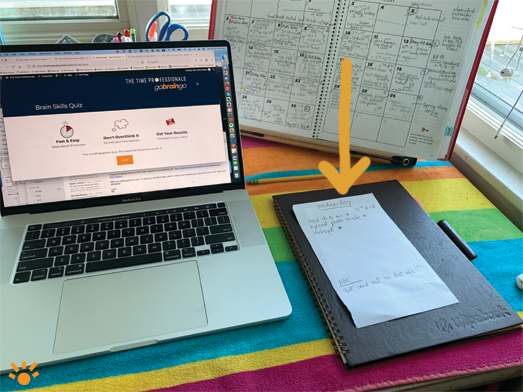What is the Optimal Desk Setup for The Brain?
[Reading time: 1 minute 25 seconds]
Last week, I met with a client who reached out because he was having trouble staying on track during the work day. When I walked into his office, I saw stacks of boxes and piles of files and disorganized papers on every single flat surface.
He knew he “should” organize the place but since he was still able to find what he needed (when he needed it), he wasn’t motivated to take the time to get organized.
So I focused on sharing techniques that support the brain skill of sustained attention (yes, I did mention decluttering… as well as using a timer to bookend chunks of time, using the morning for tasks that are the hardest to stay focused on, etc.) but the idea that really hit home for him was when I identified the "prime real estate" on his desk.
The most important space on the desk
Prime real estate on a desk is the area next to your computer keyboard where you already quite naturally place whatever it is that you're working on. But we use it unconsciously.
If you're right-handed and use a trackpad, the open space immediately to the right of your keyboard is the prime/most valuable real estate on your desk. (see photo)
If you use a mouse with your right hand, the space to the left of your keyboard is prime.
What's the best thing to put there?
Your Daily To Do list!
Why?
Because when that list is close at hand and easy to see, it's going to be easy to use.
And when something is easy to use, we're more apt to actually use it.
What my client also appreciated was that after about two days, his brain (and muscle memory) started expecting his To Do list to be there! We are creatures of habit and thankfully some habits don't take long to stick...
Three immediate benefits
Having this easy "home" for his daily To Do list meant:
- He had a place to look when he felt derailed.
By interruptions, distractions, any shiny thing that demanded attention... - He could quickly and easily write things down.
These could be more things he wanted to do - but it could also be whatever random thoughts he didn't want to forget (schedule an oil change, pick up dog food on the way home...) - He didn't have to rely on remembering what he wanted to get done.
Trying to remember items on a To Do list is a huge press on Working Memory. The busier the day, the harder it gets to keep it all straight!
A triple-win!
What is Working Memory?
Working Memory is about our brain's ability to remember things. How many chunks of information can your brain hold before that first item gets forgotten?
When we read, our brains can feel overloaded by the sheer volume of the content we're taking in. If our Working Memory isn't strong, we're going to have a difficult time retaining very much.
Support your brain where it needs support and you'll stay on top of the things that are important to you.
GoBrainGo: Our brain-based videos put you in the driver's seat of your life.
Stay Connected
Join our mailing list to receive new blog posts.
Don't worry, your information will not be shared.
We hate SPAM. We will never sell your information, for any reason.




